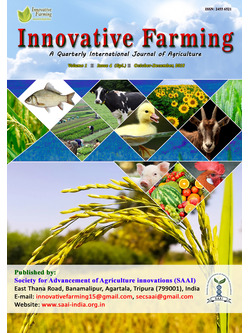
Diversity of Predatory Spider and their Species Composition in Rice Ecosystem in Kolasib District of Mizoram
Samik Chowdhury*
ICAR-Research Complex for NEH Region, Mizoram Centre, Kolasib, Mizoram-796081, INDIA
T. Boopathi
ICAR-Research Complex for NEH Region, Mizoram Centre, Kolasib, Mizoram-796081, INDIA
Ardhendu Chakraborty
Dept. of Plant Protection, Palli Shiksha Bhavana, Vishva Bharati, Sriniketan, West Bengal-791236, INDIA
Pritin P. Sontakke
Dept. of Plant Protection, Kerala Agricultural University (KAU), Vellayani, Thiruvananthapuram, Kerala-695522, INDIA
Tapas Paul
Dept. of GPB and Plant Physiology, Palli Shiksha Bhavana, Vishva Bharati, Sriniketan, West Bengal-791236, INDIA
Debashre Bhattacharjee
Dept. of Plant Protection, Palli Shiksha Bhavana, Vishva Bharati, Sriniketan, West Bengal-791236, INDIA
Joy Kumar Dey
Dept. of Agronomy, Palli Shiksha Bhavana, Vishva Bharati, Sriniketan, West Bengal-791236, INDIA
Jayashree Bhattacharjee
Dept. of Plant Pathology, Bidhan Chandra Krishi Vishwavidyalaya, Mohanpur, West Bengal-741252, INDIA
DOI: NIL
Keywords: Rice ecosystem, Spider, Lycosidae, Tetragnathidae
Abstract
Spider is one of the most abundant beneficial arthropods in rice ecosystem of Mizoram. Most of them are polyphagous predators in rice ecosystem, able to feed on various insect pests of rice ecosystem. In this context, ICAR Research Complex for NEH Region, Mizoram centre has taken an initiative to describe the diversity of spider communities in the rice growing area of Kolasib, Mizoram. About 8336 specimens were collected from different rice ecosystems of Mizoram and conserved for further characterization and evaluation. A total of 10 family, 20 genera and 31 species were collected from different rice productive areas of Kolasib, Mizoram. The most dominant species were Lycosa pseudoannulata (Boosenbery & Stard) followed by Oxyopes lineatipes (C.L. Koch), Oxyopes javanus Thorell, Tetragnatha maxillosa Thorell, Thomisus pugilis and Phidippus audax. The collective contribution of these six species was 70.52%. Lycosidae was the most dominant family in the ground sample while Tetragnathidae was the most dominant in the foliage sample.
Downloads
not found
Reference
Barnes, R.D., & Barnes, M.B. (1954). The spider population of the abstract broomsedge community of the southeastern Piedmont. Ecology, 36, 658–666.
Bartos, M. (2005). The life history of Yellenus arenarius (Araneae, Salticidae), Evidence for sympatric populations isolated by the year of maturation. Journal of Arachnology, 33, 214–221.
Coddington, J.A. (1986). The genera of the spider family Theridiosomatidae. Smithsonian Contributions of Zoology, 422, 1–96.
Dyal, S. (1935). Fauna of Lahore: spiders of Lahore. Bulletin of Zoology Punjab University, 1, 119–252.
Hrowood, J.D., Sunderland, K.D., & Symondson, O.C. (2001). Living where the food is: web location by linyphiid spiders in relation to prey availability in winter wheat. Journal of Applied Ecology, 38, 88–99.
Kamal, N.Q., Begum, A., & Biswas, V. (1992). Studies on the abundance of spiders in rice ecosystem. Journal of Insect Science, 5(1), 30–32.
Levi, H.W. (1981). The American orb-weaver genera Dolichognatha and Tetragnatha north of Mexico (Araneae: Araneidae, Tetragnathidae). Bulletin of the Museum of Comparative Zoology, 149(5), 271–318.
Ludwig, J.A., & Reynolds, F. (1988). Statistical Ecology: A Primer on Methods in Computing. John Wiley and Sons.
Mansour, F., Rosen, D., Shulov, A., & Plaut, H.N. (1980). Evaluation of spiders as biological control agents of Spodoptera littoralis larvae on apple in Israel. Acta Oecologica, 1, 225–232.
Nyffeler, M., & Benz, G. (1987). Spiders in natural pest control: a review. Journal of Applied Entomology, 103, 321–339.
Nyffeler, M., Dean, D.A., & Sterling, W.L. (1987a). Predation by green lynx spider, Peucetia viridians (Araneae: Oxyopidae), inhabiting cotton and woolly croton plants in East Texas. Environmental Entomology, 16, 355–359.
Platnick, N.I. (2005). The World Spider Catalog, version 6.0. American Museum of Natural History.
Platnick, N.I. (2007). The World Spider Catalog, version 8.0. American Museum of Natural History.
Proszynski, J., & Zechowska, K. (1981). Redescription of the O.P. Cambridge Salticidae (Araneae). Polskie Pismo Entomologiczne, 51, 13–35.
Proszynski, J. (2003). Monograph of the Salticidae (Araneae) of the World. Part I: DATABASE.
Rezac, M., Pekar, S., & Kocourek, F. (2006). Effect of Bt-Maize on epigeic spiders (Araneae) and harvestman (Opiliones). Plant Protection Science, 42, 1–8.
Riechert, S.E., & Bishop, L. (1990). Prey control by an assemblage of generalist predators: spiders in garden test systems. Ecology, 71, 1441–1450.
Schmidt, H.M., & Tscharntke, T. (2005). Landscape context of sheet web spider abundance in cereal fields. Journal of Biogeography, 32, 467–473.
Sebastian, P.A., Mathew, M.J., Pathummal, S.B., Joseph, J., & Biju, H.C. (2005). The spider fauna of the irrigated rice ecosystem in central Kerala, India. Journal of Arachnology, 33, 247–255.
Settle, H.W., et al. (1996). Managing tropical rice pests through conservation of generalist natural enemies and alternative prey. Ecology, 77(7), 1975–1988.
Sronu, F., & Szinetar, C. (2002). On the nature of agrobiont spiders. Journal of Arachnology, 30, 389–402.
Taher, M.A., Sattar, M.A., Rahaman, M.M., & Alom, M.M. (2009). Biodiversity of Madhupur Forest. Journal of Bangladesh Society of Agricultural Science and Technology, 6(1&2), 217–222.
Tikader, B.K., & Biswas, B. (1981). Spider fauna of Calcutta and vicinity. Records of the Zoological Survey of India, 30, 1–149.
Tikader, B.K., & Malhotra, M.S. (1980). The Fauna of India. Zoological Survey of India, 1(2), 272–439.
Tikader, B.K. (1987). Handbook of Indian Spiders. Zoological Survey of India, Calcutta.
Uetz, G.W., Halaj, J., & Cady, A.B. (1999). Guild structure of spiders in major crops. Journal of Arachnology, 27, 270–280.
Watanabe, I., & Roger, P.A. (1985). Ecology of flooded rice fields. In: Wetland Soils: Characterization, Classification and Utilization. IRRI, Philippines, pp. 230–242.
Zou, J., Huang, Y., & Jiang, J. (2005). A 3-year field measurement of methane and nitrous oxide emissions from rice paddies in China. Global Biogeochemical Cycles, 19, GB2021.
